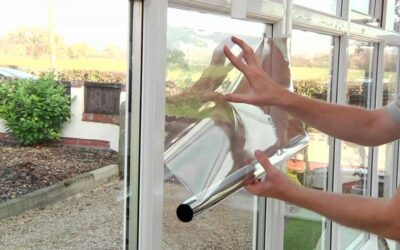Are you dealing with old, bubbling, or discolored window film? Whether you’re upgrading to a better tint or just want to restore your windows to their original condition, learning how to take tinted window film off properly can save you time, money, and frustration.
In this detailed guide, we’ll walk you through step-by-step instructions on how to safely remove tinted film from your windows—whether at home, in your car, or at your business. We’ll also explain when it’s best to call in professionals like the team at Columbine Window Tint, Denver’s trusted commercial and residential window film experts.
Why You Might Need to Remove Tinted Window Film
Over time, even high-quality window films degrade. If you notice the following issues, it’s time to take the old tint off:
Bubbling or peeling film
Faded or purple discoloration
Scratches or cracks on the surface
Reduced clarity or visibility
Regulations requiring removal
You’re ready to upgrade to a better window film
No matter the reason, it’s important to remove tinted film correctly to avoid damaging the glass underneath.
Tools You’ll Need to Remove Window Tint
Before starting, gather the following tools and supplies:
Spray bottle filled with warm soapy water or ammonia solution
Utility knife or razor blade scraper
Plastic scraper or old credit card
Lint-free cloths or paper towels
Garbage bags or black plastic sheets (for the sun method)
Heat gun or hairdryer
Protective gloves (especially when using ammonia)
Glass cleaner
Having the right tools ensures a smoother, safer removal process—especially for large windows or older film.
Method 1: Heat and Peel (Great for Small or Newer Films)
This is a straightforward technique ideal for removing lightly aged window film from a single pane or car window.
Step-by-Step Instructions:
Step 1: Warm the Film
Use a heat gun or hairdryer on high to heat the surface of the film. Hold it a few inches away and move it in circular motions to soften the adhesive.
Step 2: Start Peeling
Lift a corner of the film with your fingernail or razor blade. Once you have a grip, peel slowly and steadily. The heat will help the adhesive come off more cleanly.
Step 3: Remove Residue
Spray any remaining adhesive with soapy water or ammonia solution. Let it soak for 5–10 minutes, then scrape gently with a plastic tool.
Step 4: Clean the Glass
Wipe the window with glass cleaner and a microfiber cloth for a streak-free finish.
Method 2: Garbage Bag and Sun Method (Best for Large or Stubborn Film)
This method works well for residential and commercial windows, especially in sunny weather.
Step-by-Step Instructions:
Step 1: Prepare the Window
Cut a black plastic trash bag to fit the size of the window.
Step 2: Spray the Window
Generously spray the tinted surface with an ammonia-based cleaner. For indoor windows, you can use warm soapy water instead.
Step 3: Apply the Bag
Press the garbage bag onto the wet window, letting it stick to the surface. The bag traps heat and helps loosen the adhesive.
Step 4: Let It Sit in the Sun
Leave the window covered for 30–60 minutes. The heat from the sun will activate the solution and soften the adhesive underneath.
Step 5: Peel and Scrape
Remove the bag and carefully peel off the film. Scrape away any remaining adhesive, then clean the window thoroughly.
Method 3: Steam Removal (Ideal for Multi-Layer Films)
A garment steamer or handheld steam cleaner is a great option for old, bubbled, or multi-layer film that’s difficult to peel.
Steps:
Hold the steamer a few inches from the film.
Slowly move the steamer across the window, softening both the film and glue.
Peel back the film carefully while applying continuous steam.
Scrape and clean any remaining residue.
Steam is a safe, non-chemical solution that works well on delicate indoor glass.
Common Mistakes to Avoid
Removing window film is straightforward—but making these mistakes can cause damage or extend the process:
Using a dry scraper – This can scratch glass or leave marks.
Skipping the soaking step – Dry adhesive is harder to remove.
Rushing the peel – Tearing the film leaves more mess behind.
Using too much force – May damage the glass or window frame.
Not ventilating the area – Especially important if using ammonia indoors.
If you’re unsure, or if the window is large or in a hard-to-reach area, it’s wise to hire a professional.
When to Call a Professional
While DIY removal can work for small projects, professional window film removal offers key advantages:
No risk of glass damage
Faster and cleaner process
Safe handling of chemicals and waste
Surface is prepped for new film installation
At Columbine Window Tint, we specialize in safe, efficient removal for both residential and commercial properties. Whether you need one window or an entire building treated, our experienced technicians ensure a clean finish every time.
Upgrading After Removal? Consider New Window Film Options
Once you’ve taken the old tint off, your windows are a blank canvas! Now is the perfect time to upgrade to modern, high-performance window film that offers:
Up to 99% UV protection
Reduced glare and solar heat
Enhanced security and shatter resistance
Frosted or decorative privacy films
Stylish finishes for modern aesthetics
As Denver’s leading window tint experts, Columbine Window Tint offers a wide range of premium film solutions tailored to your space, goals, and budget.
FAQs About Window Film Removal
Q: Can I just apply new film over the old one?
A: No. Always remove the old film first to ensure the new layer adheres properly and lasts longer.
Q: How long does it take to remove window tint?
A: For a single window, 30–60 minutes. For an entire home or office, professional removal may take several hours.
Q: Will removal damage my windows?
A: Not if done properly. Avoid using sharp tools on dry glass, and always keep the surface wet while scraping.
Q: Does window film leave permanent residue?
A: No, but some adhesives are tougher than others. Proper soaking or steaming removes most residue safely.
Final Thoughts: Remove Window Film the Right Way
Knowing how to take tinted window film off safely and effectively helps you protect your windows and prepare for future upgrades. Whether you use heat, ammonia, or steam, the key is patience, proper tools, and attention to detail.
But for large-scale jobs or guaranteed results, don’t hesitate to contact the pros.










